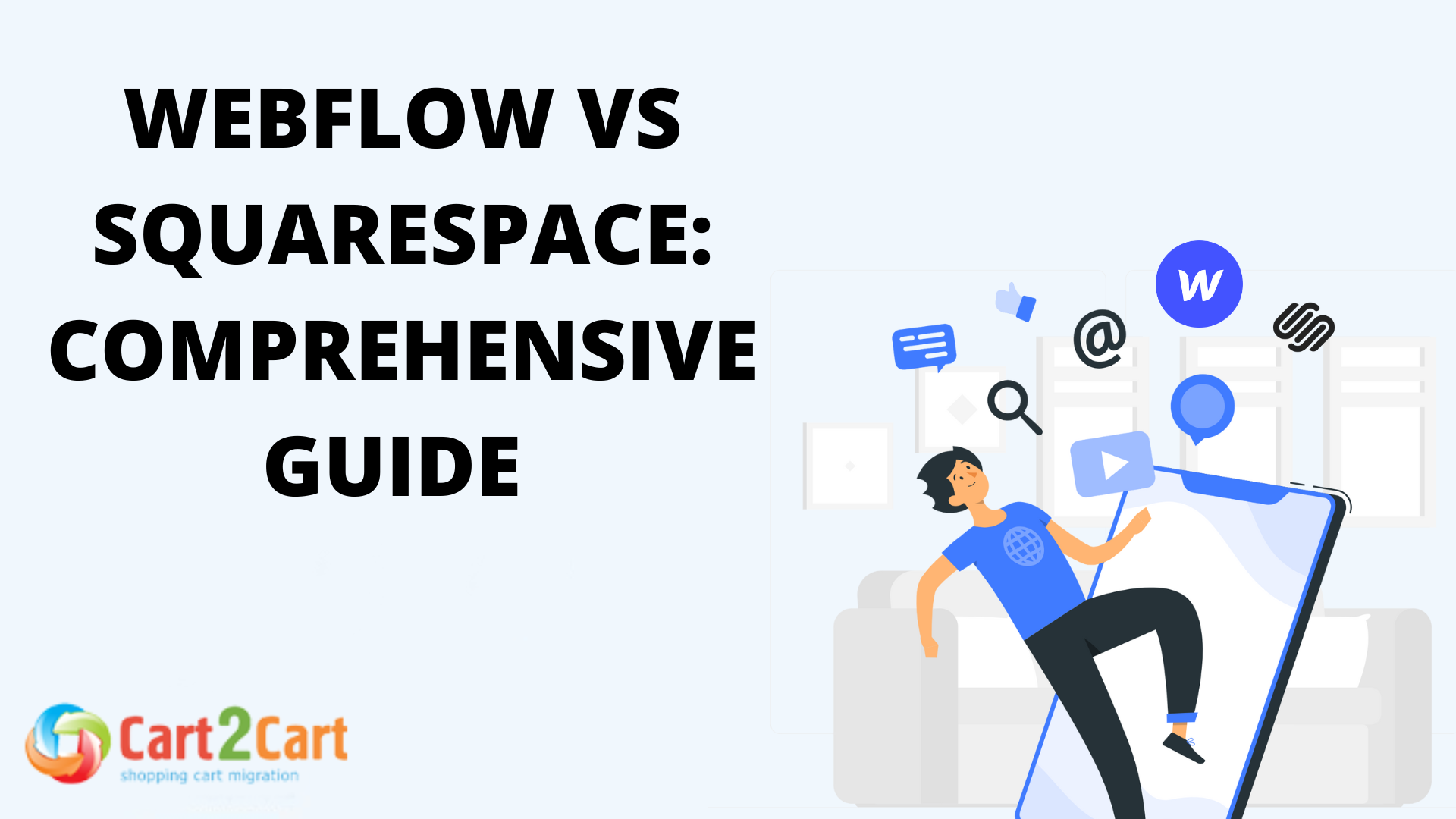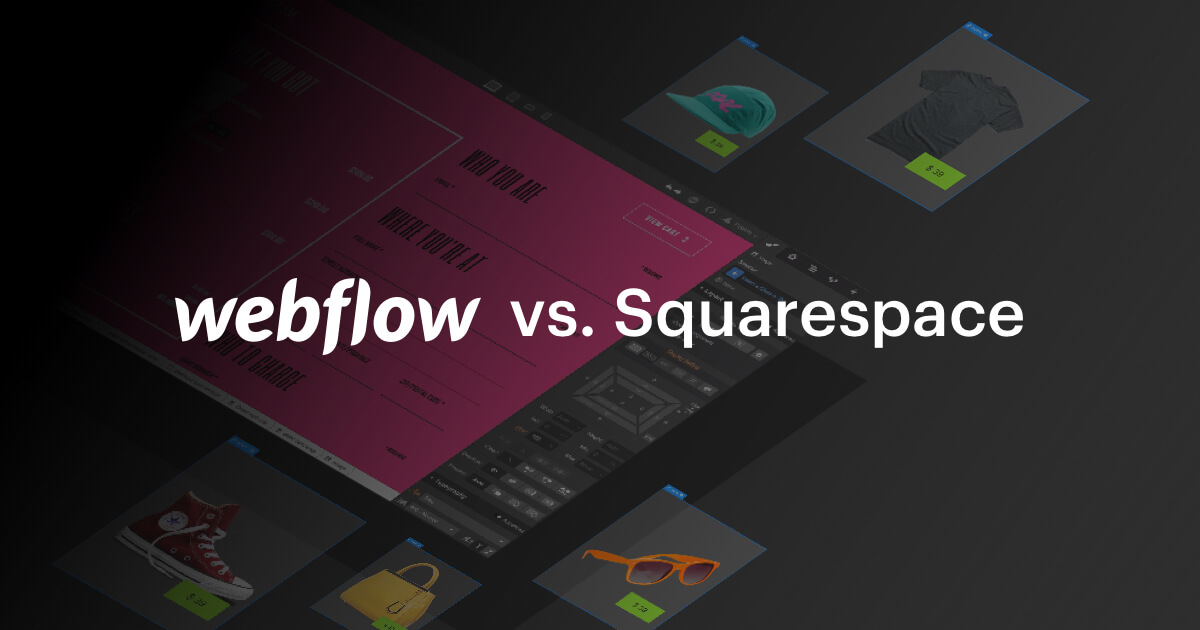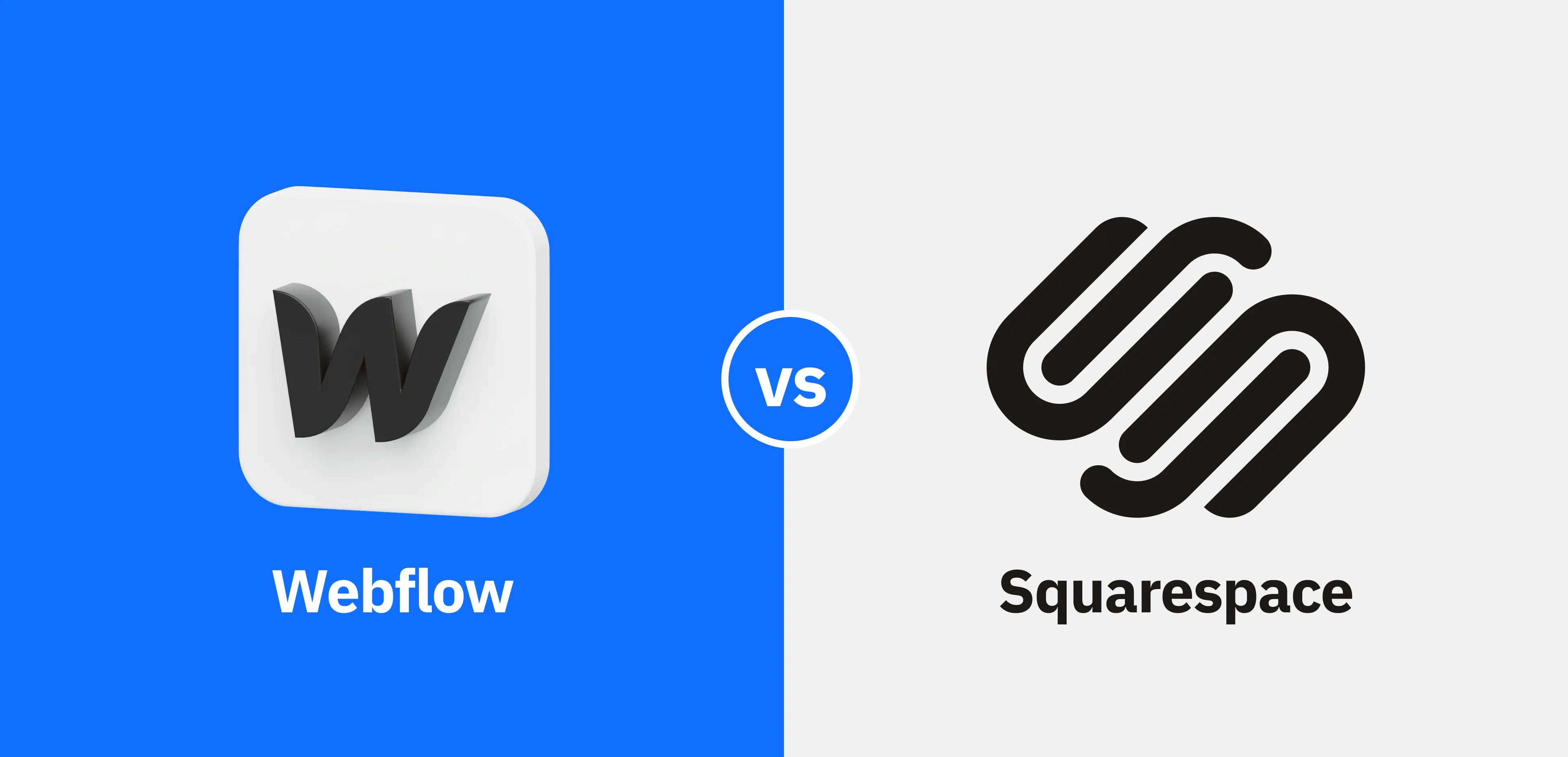
In the world of website building, Webflow and Squarespace are two prominent players. Each platform offers unique features and capabilities, catering to different types of users. This comprehensive guide will delve into the nuances of Webflow vs Squarespace, helping you make an informed decision based on your specific needs and preferences. We’ll explore their key features, design capabilities, ease of use, pricing, and more, including their ecommerce functionality and options for eCommerce Migration Service. For those seeking even more extensive support, our Ultimate Data Migration Service provides a full-fledged solution. Additionally, we’ll discuss the flexibility of setting up a custom domain on each platform.
What is Webflow?
Webflow is a powerful website builder and content management system (CMS) that allows users to design, build, and launch custom websites with a free custom domain without needing to code. It combines a visual editor with a CMS, offering flexibility and control over the design and functionality of your site. Webflow is particularly popular among designers and developers who require advanced customization options and ecommerce features.
Key Features of Webflow
- Visual Designer: Webflow’s visual editor provides a high level of design control. Users can create responsive layouts using a drag-and-drop interface, with real-time previews of their work.
- CMS Capabilities: The CMS feature in Webflow allows for dynamic content management. Users can create custom content types and fields, manage blog posts, portfolios, and other dynamic content effortlessly. Platforms like Magento also offer robust CMS capabilities for complex store setups.
- Responsive Design: Webflow enables users to design websites that are automatically responsive across different devices and screen sizes. This feature ensures that your site looks great on desktops, tablets, and smartphones.
- SEO Tools: Webflow includes advanced SEO features such as customizable meta tags, alt attributes for images, and automatic sitemap generation. These tools help optimize your site for search engines.
Design Flexibility
Webflow is renowned for its extensive design capabilities. Unlike other website builders, Webflow provides precise control over every aspect of your site’s design. You can manipulate elements with detailed CSS, adjust animations, and use advanced interactions to create a unique and engaging user experience.
Use Cases for Webflow
- Professional Designers: Webflow is ideal for web designers who want to bring their creative visions to life without being constrained by template limitations.
- Dynamic Websites: Websites that require complex content structures, such as blogs, portfolios, and e-commerce sites, can benefit from Webflow’s robust CMS capabilities.
- Custom Solutions: Developers looking for a high degree of customization and control over website functionality will find Webflow’s features particularly appealing.
What is Squarespace?
Squarespace is a popular website builder known for its sleek, designer-quality templates and user-friendly interface. It offers a free plan that allows users to explore its features before committing to a paid subscription. With unlimited bandwidth, Squarespace ensures that your website can handle high traffic without performance issues. As a comprehensive web design tool, it’s designed to be accessible to users of all skill levels, making it a great option for individuals and small businesses looking to create a professional website with minimal effort.
Key Features of Squarespace
- Templates: Squarespace offers a wide range of beautifully designed templates that are easy to customize. These templates are designed with a focus on aesthetics and functionality, providing a strong foundation for your site.
- Ease of Use: Squarespace’s drag-and-drop editor is intuitive and user-friendly. It allows users to add and arrange content, customize layouts, and make design adjustments with ease.
- E-commerce: Squarespace includes built-in e-commerce functionality, making it simple to set up an online store. You can manage products, track inventory, and handle transactions directly from the platform.
- Analytics: Squarespace provides integrated analytics tools to help you track website performance, visitor behavior, and other key metrics. This data can be valuable for optimizing your site and improving user engagement.
Design Flexibility
While Squarespace offers a range of stylish templates, it has less design flexibility compared to Webflow. The platform’s design customization options are more limited, which can be both an advantage and a disadvantage. For users who prefer a straightforward design process without extensive customization, Squarespace’s templates are a great fit.
Use Cases for Squarespace
- Small Businesses: Squarespace is well-suited for small businesses that need a professional website quickly and affordably. The platform’s built-in e-commerce tools and easy-to-use interface make it a practical choice for online stores. Many users considering an expansion might also explore migrating from Squarespace to Shopify for broader e-commerce functionalities.
- Personal Websites: Individuals looking to create personal blogs, portfolios, or informational sites will benefit from Squarespace’s elegant templates and simple customization options.
- Non-Technical Users: Those who lack technical skills or coding knowledge will find Squarespace’s user-friendly interface and pre-designed templates to be an attractive option.
Webflow vs Squarespace: Detailed Comparison
To help you compare Webflow vs Squarespace more effectively, here is a summary of their features, pricing, and other important aspects:
| Feature | Webflow | Squarespace |
|
Design Flexibility |
High: Extensive customization with full control over CSS and interactions | Moderate: Limited to template-based customization |
| Ease of Use | Intermediate: Requires some learning curve, especially for beginners | High: User-friendly with an intuitive drag-and-drop interface |
| CMS Functionality | Advanced: Custom content types, dynamic content, and comprehensive blog management | Basic: Standard CMS features with predefined content types |
| E-commerce | Advanced: Customizable online store with extensive options | Basic: Built-in e-commerce with straightforward setup |
| SEO Tools | Advanced: Detailed SEO options including customizable meta tags and sitemaps | Basic: Standard SEO features integrated into the platform |
| Pricing | Higher: Plans vary based on features and usage | Lower: Affordable plans with different levels of functionality |
Ease of Use
Webflow:
- Learning Curve: Webflow has a steeper learning curve, especially for those unfamiliar with web design principles. However, it provides a wealth of resources, including tutorials and documentation, to help users get acquainted.
- User Experience: The platform’s advanced features and flexibility might be overwhelming for beginners but offer significant advantages for experienced users.
Squarespace:
- Learning Curve: Squarespace is known for its ease of use. The drag-and-drop interface is intuitive, making it accessible to users of all skill levels.
- User Experience: Users can quickly build and launch a website without needing extensive design or technical knowledge. Squarespace’s simplicity is a major draw for many users.

CMS and Content Management
| Feature | Webflow | Squarespace |
| CMS Functionality | Advanced: Custom content types, dynamic content, and blog management | Basic: Predefined content types and limited customization |
| Content Editing | Advanced: Rich text fields, custom content management | Simple: Inline editing with limited options |
| Blog Management | Flexible: Customizable blog layouts and post types | Standard: Built-in blog features with templated layouts |
E-commerce
Webflow:
- Capabilities: Webflow offers comprehensive e-commerce features, including customizable product pages, advanced shipping options, and integration with payment gateways.
- Complexity: Setting up an online store in Webflow can be more complex compared to Squarespace. It is better suited for users who need extensive customization and have experience with web development.
Squarespace:
- Capabilities: Squarespace provides a straightforward e-commerce solution with built-in features for managing products, orders, and payments.
- Ease of Use: Setting up an online store is relatively simple, making it an attractive option for users who want an out-of-the-box solution without the need for extensive customization.
SEO and Analytics
| Feature | Webflow | Squarespace |
| SEO Tools | Advanced: Customizable meta tags, alt attributes, and sitemap | Basic: Standard SEO features with limited customization |
| Analytics | Integrated: Advanced analytics and third-party integrations | Built-in: Basic analytics with an easy-to-understand dashboard |
Pricing Comparison
Here’s a breakdown of the pricing plans for both Webflow and Squarespace:
| Plan | Webflow Pricing (Monthly) |
Squarespace Pricing (Monthly) |
|
Basic Plan |
$14 | $18 |
| CMS Plan | $23 | $28 |
| Business Plan | $39 | $36 |
| E-commerce Plan | $49 | $52 |
Webflow Pricing Details
- Basic Plan: Suitable for small websites with basic needs. Includes Webflow branding and limited features.
- CMS Plan: Adds advanced CMS features, suitable for content-heavy sites like blogs.
- Business Plan: Includes e-commerce functionality and more advanced features.
- E-commerce Plan: Designed for users who need comprehensive online store capabilities.
Squarespace Pricing Details
- Personal Plan: Basic website features with limited functionality.
- Business Plan: Includes e-commerce features and additional customization options.
- Basic Commerce Plan: Designed for small online stores with essential e-commerce features.
- Advanced Commerce Plan: Offers advanced e-commerce features, including abandoned cart recovery and advanced shipping options.

Choosing the Right Platform for You
Deciding between Webflow and Squarespace depends on your specific needs, budget, and level of expertise. Here are some considerations to help you make the right choice:
- Design and Customization: If you need extensive design flexibility and control, Webflow is the better option. Its advanced features allow for highly customized designs and interactions.
- Ease of Use: For a user-friendly experience with minimal learning curve, Squarespace is ideal. Its intuitive interface and pre-designed templates make it easy to create a professional website quickly.
- CMS and Content Management: Webflow excels in content management with its advanced CMS capabilities. If you require dynamic content and custom content types, Webflow is the way to go. For simpler content management needs, Squarespace’s built-in CMS will suffice.
- E-commerce: If you need a highly customizable online store, Webflow offers more advanced e-commerce features. For a straightforward, easy-to-setup online store, Squarespace’s built-in e-commerce tools are a great choice.
- Pricing: Consider your budget and the features you need. Squarespace generally offers more affordable pricing plans, while Webflow’s pricing can be higher, especially if you require advanced design and e-commerce capabilities.
FAQs
Can I use Webflow for e-commerce?
Yes, Webflow provides e-commerce functionality, allowing you to create and manage an online store using Webflow templates. However, it is more complex to set up compared to Squarespace, which might be better suited for users seeking a simpler solution for their ecommerce website.
Is Squarespace suitable for professional web designers?
While Squarespace is user-friendly and provides beautiful templates, it offers less design flexibility compared to Webflow. Webflow University offers extensive resources and tutorials, which can help professional web designers who require more customization. For those who need advanced design features, Webflow may be more suitable for their needs.
Which platform is more cost-effective for a small business?
Squarespace is generally more cost-effective for small businesses due to its lower pricing plans and included e-commerce features. Webflow’s pricing can be higher, especially if you require advanced design and e-commerce capabilities.
Monthly Update – December 2025
The close of 2025 highlights the undeniable dominance of mobile-first design and enhanced accessibility in the e-commerce sector. With a significant portion of online shopping now occurring on smartphones and tablets, optimizing your website for mobile performance is no longer a luxury but a critical necessity. Webflow, with its granular control over responsive design, empowers developers to craft pixel-perfect mobile experiences, ensuring fast load times and intuitive navigation. Squarespace, while offering elegant templates, also emphasizes responsive layouts, making it easier for users to achieve a mobile-friendly site out-of-the-box. Beyond aesthetics, accessibility has become a key differentiator, impacting both user experience and SEO. Implementing WCAG standards, providing clear alt text for images, and ensuring keyboard navigation are vital. Future-proofing your online store means prioritizing an inclusive design that caters to all users, regardless of device or ability. This focus not only expands your potential customer base but also signals to search engines a commitment to quality and user value.
For more details, explore our FAQ section or schedule a call with a migration expert.





